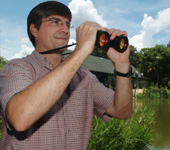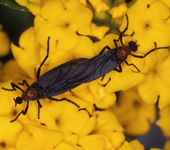|
All About Wetlands >> Wildlife
Wetland Wildlife
Though wetlands are most often associated with waterfowl and bird species, they provide essential habitat for a wide variety of species - birds, mammals, reptiles, amphibians, fish, and insects - up to 45% of which are rare and endangered. The high rate of wetland loss has contributed to the endangered status of many species. Some species, such as the wood duck and muskrat, spend most of their life within wetlands, while others - striped bass, peregrine falcon and deer - occasionally visit wetlands for food, water, or shelter. Those species that require wetland habitat to complete at least a portion of their life cycle are called obligate species.(1)
Why are wetlands favored by so many species? They attract wildlife for a number of reasons:(1)
- their vegetative cover provides shelter from predators;
- they provide ideal nesting conditions for many waterfowl;
- they provide migratory birds with a safe stop-over location to rest during long migrations;
- they provide essential spawning and nursery habitat for commercially important fish and shellfish;
- many have an extensive, complex food chain that supports numerous species, including man.
|
Local Field Guides
U.S. Local Wildlife Guides: What's in Your Backyard?
Enter your zip code and get a local wildlife guide specific to your area of Florida. Guides include photographs, audio clips and track identification for mammals, birds, amphibians, reptiles, butterflies and trees and wildflowers.
Top of Page |
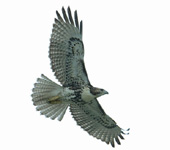 |
Threatened, Endangered and Exotic Species
Federal List of Threatened and Endangered Animals
List of endangered and threatened species as published in the Endangered and Threatened Wildlife and Plants 50 CFR 17.11 and 17.12, December 1999. Also includes monthly statistics and searchable database.
Florida's Endangered Species,Threatened Species and Species of Special Concern
The official 1997 Florida lists with statistics.
Florida Exotic Wildlife
Fact sheets on exotic and naturalized wildlife species and breakdown of species listings by county. Includes statewide and county statistics of exotic species. Fact sheets include population estimates and explains threats to native species.
Top of Page |
|
Invertebrates and Insects
Freshwater Snails of Florida
Fieldguide with dichotmous key identification, tips for preparing specimens and detailed information on each family.
Venomous Spiders of Florida
Guide for widow and recluse spiders of Florida including close up photos and proper identification tips.
Top of Page |
| |
Fish and Aquatic Wetland Animals
Biological profiles of fish
Thorough fact sheets on Florida's fish species including explanations of taxonomy, geographic distribution, habitat, unique biology, importance to humans and conservation.
Top of Page |
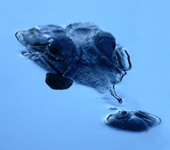 |
Reptiles and Amphibians
Herpetology at the Florida Museum of Natural History
Information and links on frogs and toads, snakes, salamanders, lizards, sea turtles, crocodiles and alligators, including a searchable bibliography of references to the Florida species.
Frogs and Toads of Florida
A guide to the 33 frog and toad species that live in Florida, including pictures and distribution informationfor each. Audio files of the animals' calls are also included for many species.
Amphibians and Reptiles of the Southeast United States and the Virgin Islands
Species fact sheets and pictures on about 30 frog and toad species and about 15 salamander species found in our area. Also includes a glossary of terms used to describe reptile and amphibian species.
Southeastern Amphibian Research and Monitoring Program
Part of a nation-wide program to determine the status and trends of amphibians populations in the U.S. Includes information on proper amphibian sampling and statistics from the Southeast research sites. Also links to an unusal publication on malformations of frogs and toads.
Online Guide to the Snakes of Florida
Field guide to Florida's snakes with fact sheets, pictures and comments on each species. Species are marked as harmless or venomous. Also includes a dichotomous key for help in indentification. Links to Snakebite Emergency First Aid.
World of the Crocodilians
An interactive guide to Crocodile species, including the American Alligator, with maps and pictures. Present by National Geographic.
Florida's Alligator Management Program
Top of Page |
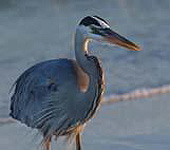 |
Waterfowl and Wading Birds
Florida Waterfowl
Fact sheets on waterfowl species, habitat conservation, waterfowl surveys, hunting information and links to waterfowl identification guides. Leg band recoveries can also be reported here.
Waterbird Colony Locator
Statewide aerial survey during 26 January-25 June 1999 to locate waterbird (herons, egrets, ibises, spoonbills, storks, anhingas, cormorants, and pelicans) breeding colonies and estimate colony size and species composition. Search by species or county.
The Great Florida Birding Trail
Official site of the 2000-mile highway trail which unifies existing and new birding sites throughout Florida. The site includes birdwatching basics for beginners, tips for birdwatching in Florida, a calendar of events and trail guides.
Breeding Bird Atlas
This Atlas project attempted to record the breeding distributions of all bird species in the state during 1986-1991. Results are available for each species, including distribution maps and fact sheets on general characteristics, habitat and seasonal occurances. The Atlas results can be searched by bird species or county.
Wings over Florida birding certificate program
This free awards program is designed to help beginning birdwatchers learn to identify birds within the state. Bird watchers can order an introductary birdwathcing packet and earn certificates based on the number of birds they identify.
Top of Page |
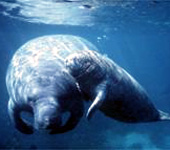 |
Mammals
Florida Panther Net
This official education site of our state animal includes a thorough section of facts on the panther with hunting, online games, acitivities, screensavers and an educator's section. The panther facts section includes several information sections with sounds, pictures and videos.
Florida Black Bear
This Florida mammal has been listed as an endangered species since 1974. The sight includes a fact sheet on the bears, a slide show and teacher curriculum guide.
Save the Manatee Club
This organization was started to involve the public in manatee conservation efforts. The site includes manatee facts, news, viewing area locations, population status information and an adopt-a-manatee program.
Top of Page
|
Works Cited
- "A World in Our Backyard: Wetland Functions." U.S. Environmental Protection Agency Wetlands Division
Wetlands Education Materials. Available in an online PDF version at: http://www.epa.gov/gmpo/education/pdfs/WorldBackyard3.pdf
Top of Page
|

